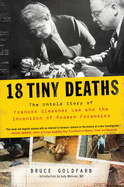
Forensic science is commonplace today. But as recently as 1944, qualified medical examiners inspected only a few deaths in the United States. In 18 Tiny Deaths: The Untold Story of Frances Glessner Lee and the Invention of Modern Forensics, journalist Bruce Goldfarb tells the fascinating story of how one woman became an unlikely crusader for forensic science in the U.S.
Frances Glessner Lee was a child of the Gilded Age in Chicago, with all the privileges and restrictions that entailed. (Unable to attend Harvard, she chose not to attend college at all.) As an adult, Lee felt the need to use her substantial resources to benefit society. She found her calling through a childhood friend, Dr. George McGrath, who was Boston's second medical examiner. McGrath introduced Lee to what was called "legal medicine," telling her stories of finished cases and describing his frustrations with the haphazard use of forensics in police work.
Lee dedicated the next 30 years to developing what she called the "three-legged stool" of legal medicine: medicine, the law and the police. She alternately seduced and bludgeoned Harvard Medical School into founding a department of Legal Medicine. Not content with giving money, she insisted on hands-on involvement, culminating in the "18 tiny deaths" of the title: detailed dioramas called the Nutshell Studies of Unexplained Death, which Lee created as tools for training police officers in scientific forensic methods.
18 Tiny Deaths combines elements of women's history and police procedurals in a story that will intrigue fans of both genres. --Pamela Toler, blogging at History in the Margins

